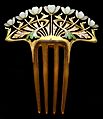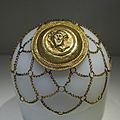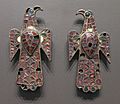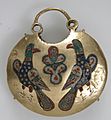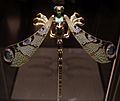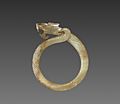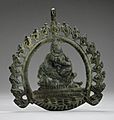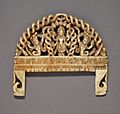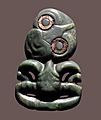Jewellery facts for kids
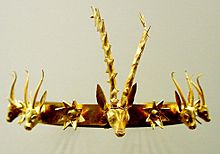
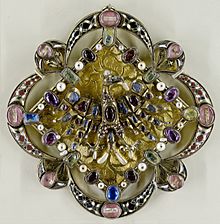

Jewellery (British English) or jewelry (American English) consists of small decorative items worn for personal adornment, such as brooches, rings, necklaces, earrings, pendants, bracelets, and cufflinks. Jewellery may be attached to the body or the clothes, and the term is restricted to durable ornaments, excluding flowers for example.
For many centuries metal, often combined with gemstones, has been the normal material for jewellery, but other materials such as shells and other plant materials may be used. It is one of the oldest type of archaeological artefact – with 100,000-year-old beads made from Nassarius shells thought to be the oldest known jewellery.
The basic forms of jewellery vary between cultures but are often extremely long-lived; in European cultures the most common forms of jewellery listed above have persisted since ancient times, while other forms such as adornments for the nose or ankle, important in other cultures, are much less common.
Jewellery may be made from a wide range of materials. Gemstones and similar materials such as amber and coral, precious metals, beads, and shells have been widely used, and enamel has often been important.
In most cultures jewellery can be understood as a status symbol, for its material properties, its patterns, or for meaningful symbols. Jewellery has been made to adorn nearly every body part, from hairpins to toe rings. The patterns of wearing jewellery between the sexes, and by children and older people can vary greatly between cultures, but adult women have been the most consistent wearers of jewellery; in modern European culture the amount worn by adult males is relatively low compared with other cultures and other periods in European culture.
Form and function
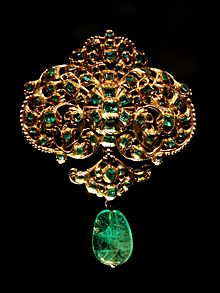
Humans have used jewellery for a number of different reasons:
- functional, generally to fix clothing or hair in place
- as a marker of social status and personal status, as with a wedding ring
- as a signifier of some form of affiliation, whether ethnic, religious or social
- to provide talismanic protection (in the form of amulets)
- as an artistic display
- as a carrier or symbol of personal meaning – such as love, mourning, or even luck
Most cultures at some point have had a practice of keeping large amounts of wealth stored in the form of jewellery. Numerous cultures store wedding dowries in the form of jewellery or make jewellery as a means to store or display coins. Alternatively, jewellery has been used as a currency or trade good.
Many items of jewellery, such as brooches and buckles, originated as purely functional items, but evolved into decorative items as their functional requirement diminished.
Jewellery can also symbolise group membership (as in the case, of the Christian crucifix or the Jewish Star of David) or status (as in the case of chains of office, or the Western practice of married people wearing wedding rings).
Wearing of amulets and devotional medals to provide protection or ward off evil is common in some cultures. These may take the form of symbols (such as the ankh), stones, plants, animals, body parts (such as the Khamsa), or glyphs (such as stylised versions of the Throne Verse in Islamic art).
History
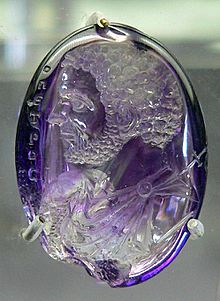
The history of jewellery is long and goes back many years, with many different uses among different cultures. It has endured for thousands of years and has provided various insights into how ancient cultures worked.
Jewelry can be made from any material. The first jewelry was made from bone, animal teeth, wood or stone. Jewelry often uses gemstones and precious metals.
Fashion jewelry or costume jewelry is jewelry that is worn just for fashion, and is not made of expensive materials.
Common jewelry types
- Earrings, which is any jewelry worn on the ears
- Necklaces, worn aroung the neck
- Finger rings and toe rings (finger rings are usually just called "ring")
- Bracelets or bangles, worn on the wrists
- Arm rings or armlets, worn on the upper arms
- Pins or Brooches, worn on clothes for decoration or keeping clothes from undoing.
- Piercings, which is jewelry that is put through holes in the skin
Images for kids
-
Hair ornament, an Art Nouveau masterpiece; by René Lalique; circa 1902; gold, emeralds and diamonds; Musée d'Orsay (Paris)
-
Khmissa amulet in silver
-
Headdress decorated with golden leaves; 2600–2400 BC; gold, lapis lazuli and carnelian; length: 38.5 cm; from the Royal Cemetery at Ur; Metropolitan Museum of Art (New York City)
-
Openwork hairnet; 300–200 BC; gold; diameter: 23 cm, diameter of the medallion: 11.4 cm; unknown provenance (said to be from Karpenissi (Greece)); National Archaeological Museum (Athens)
-
The Great Cameo of France; second quarter of the 1st century AD; five-layered sardonyx; 31 x 26.5 cm; Cabinet des médailles (Paris)
-
Russian earring; 19th century; silver, enamel and red glass beads; overall: 6.4 x 2.6 cm; Cleveland Museum of Art (Cleveland)
-
Breastplate with a peacocks; René Lalique; circa 1898–1900; gold, enamels, opals and diamonds; Calouste Gulbenkian Museum (Lisboa, Portugal)
-
Necklace with Shiva's family; late 19th century; gold inlaid with rubies, a diamond Rudraksha beads (elaeo carpus seeds) and silver back plate on clasp; overall: 38.1 cm; Los Angeles County Museum of Art (Los Angeles, US)
-
Moche ear jewellery; 3rd–7th century; gold, turquoise, sodalite and shell; diameter: 8 cm; Metropolitan Museum of Art (New York City)
-
Bai-De-Schluch-A-Ichin or Be-Ich-Schluck-Ich-In-Et-Tzuzzigi (Slender Silversmith) "Metal Beater," Navajo silversmith, photo by George Ben Wittick, 1883
-
Indian actress Shraddha Kapoor showcasing modern Indian-style jewellery
-
String of beads; 3650–3100 BC; lapis lazuli (the blue beads) and travertine (the white beads) (Egyptian alabaster); length: 4.5 cm; by Naqada II or Naqada III cultures; Metropolitan Museum of Art (New York City)
-
String of beads; 3300–3100 BC; carnelian, garnet, quartz and glazed steatite; length: 20.5 cm; by Naqada III culture Metropolitan Museum of Art
-
Armlet with sun symbol; 16th-13th century BC (late Bronze Age); bronze; German National Museum (Nürnberg)
-
Necklace; probably 2600–1300 BC; carnelian, bone and stone; from Saruq Al Hadid (the United Arab Emirates)
-
Pectoral (chest jewellery) of Tutankhamun; 1336–1327 BC (Reign of Tutankhamun); gold, silver and meteoric glass; height: 14.9 cm (5.9 in); Egyptian Museum (Cairo)
-
Pendant; circa 1069 BC; gold and turquoise; overall: 5.1 x 2.3 cm; Cleveland Museum of Art (Cleveland)
-
Signet ring; 664–525 BC; gold; diameter: 3 × 3.4 cm; British Museum (London)
-
Pectoral and necklace of Princess Sithathoriunet; 1887–1813 BC; gold, carnelian, lapis lazuli, turquoise, garnet & feldspar; height of the pectoral: 4.5 cm (1.8 in); Metropolitan Museum of Art (New York City)
-
Necklace; 2600–2500 BC; gold and lapis lazuli; length: 22.5 cm; Royal Cemetery at Ur (Iraq); Metropolitan Museum of Art
-
Pair of earrings with cuneiform inscriptions, 2093–2046 BC; gold; Sulaymaniyah Museum (Sulaymaniyah, Iraq)
-
Sumerian necklaces and headgear discovered in the royal (and individual) graves of the Royal Cemetery at Ur, showing the way they may have been worn, in British Museum (London)
-
The Bee Pendant, an iconic Minoan jewel; 1700–1600 BC; gold; width: 4.6 cm; from Chrysolakkos (gold pit) complex at Malia; Archaeological Museum of Heraklion (Heraklion, Greece)
-
Mycenaean necklace; 1400–1050 BC; gilded terracotta; diameter of the rosettes: 2.7 cm, with variations of circa 0.1 cm, length of the pendant 3.7 cm; Metropolitan Museum of Art (New York City)
-
The Vulci set of jewelry; early 5th century; gold, glass, rock crystal, agate and carnelian; various dimensions; Metropolitan Museum of Art (New York City)
-
Bulla with Daedalus and Icarus; 5th century BC; gold; 1.6 × 1 × 1 cm; Walters Art Museum (Baltimore)
-
Cameo portrait of the Emperor Augustus; 41–54 AD; sardonyx; 3.7 × 2.9 × 0.8 cm; Metropolitan Museum of Art (New York City)
-
Bracelet; 1st–2nd century AD; gold-mounted crystal and sardonyx; length: 19.69 cm; Los Angeles County Museum of Art (Los Angeles)
-
The Eagle-shaped fibulae of Alovera; 5th century; gold, bronze and glass (imitation of garnet); height: 11.8 cm, width: 5.9 cm; from Guadalajara (Spain); National Archaeological Museum (Madrid, Spain)
-
Shoulder-clasps from Sutton Hoo; early 7th century; gold, glass & garnet; length: 12.7 cm; British Museum (London)
-
Front of a temple pendant with two birds flanking a tree of life; 11th–12th century; cloisonné enamel & gold; overall: 5.4 x 4.8 x 1.5 cm; made in Kyiv (Ukraine); Metropolitan Museum of Art (New York City)
-
The Dragonfly brooch; by René Lalique; circa 1897–1898; gold, vitreous enamel, chrysoprase, chalcedony, moonstone and diamond; height: 23 cm, width: 26.5 cm; Calouste Gulbenkian Museum (Lisboa, Portugal)
-
Necklace; by René Lalique; 1897–1899; gold, enamel, opals and amethysts; overall diameter: 24.1 cm; Metropolitan Museum of Art (New York City)
-
Hair ornament, an Art Nouveau masterpiece; by René Lalique; circa 1902; gold, emeralds and diamonds; Musée d'Orsay (Paris)
-
Fluted ring with a dragon head (huan); circa 475 BC; jade (nephrite); overall: 9.1 cm; Cleveland Museum of Art (Cleveland)
-
Xin 心 shaped jewelry; 1368–1644; gold, ruby, pearl and other gemstones; about the size of an adult human's palm; Dingling (Beijing, China)
-
Hat ornament; 18th–19th century; gold, gilded metal, kingfisher feathers, glass and semiprecious stones; various dimensions; Metropolitan Museum of Art (New York City)
-
Pendant probably with Siddha; 8th–9th century; copper alloy; 8.89 x 7.93 x .31 cm; Los Angeles County Museum of Art (Los Angeles)
-
Earring with Vishnu riding Garuda; circa 1600; gold set with jewels and semi-precious stones; overall: 2.6 cm; from Nepal; Cleveland Museum of Art (Cleveland)
-
Earring with four-armed Vishnu riding Garuda with Nagas (serpent divinities); circa 1600; repousse gold with pearls; overall: 3.6 cm; from Nepal; Cleveland Museum of Art
-
Pair of Maya earflare frontals; 3rd–6th century; jade (jadeite); height: 5.1 cm; Metropolitan Museum of Art (New York City)
-
Pendant with 2 bat-head warriors who carry spears; 11th–16th century; gold; overall: 7.62 cm (3 in.); from the Chiriqui Province (Panama); Metropolitan Museum of Art
-
Double-headed serpent; 1450–1521; Spanish cedar wood (Cedrela odorata), turquoise, shell, traces of gilding & 2 resins are used as adhesive (pine resin and Bursera resin); height: 20.3 cm, width: 43.3 cm, depth: 5.9 cm; British Museum (London)
-
Māori hei-tiki; 1500–1800; jade (nephrite), abalone shell and pigments; from the New Zealand; Musée du quai Branly – Jacques Chirac (Paris)
-
Hei-tiki; 18th century; nephrite and haliotis shell; 10.9 cm; from the New Zealand; Los Angeles County Museum of Art (Los Angeles)
-
Hawaiian pendant; 18th–19th century; whalebone; height: 6 cm, width, 3.8 cm; Metropolitan Museum of Art (New York City)
See also
 In Spanish: Joyería para niños
In Spanish: Joyería para niños



